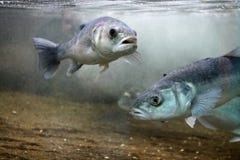Seagull (Silver Gull). Gulls (Often Informally Seagulls) Are Birds In The Family Laridae. They Are Most Closely Related To The Terns (Family Sternidae) And Only Distantly Related To Auks, And Skimmers, And More Distantly To The Waders. Most Gulls Belong To The Large Genus Larus. They Are Typically Medium To Large Birds, Usually Grey Or White, Often With Black Markings On The Head Or Wings. They Have Stout, Longish Bills, And Webbed Feet. Gull Species Range In Size From The Little Gull, At 120 G (4.2 Oz) And 29 Cm (11.5 Inches), To The Great Black-Backed Gull, At 1.75 Kg (3.8 Lbs) And 76 Cm (30 Inches). Most Gulls, Particularly Larus Species, Are Ground Nesting Carnivores, Which Will Take Live Food Or Scavenge Opportunistically. The Live Food Often Includes Crabs And Small Fish. Apart From The Kittiwakes, Gulls Are Typically Coastal Or Inland Species, Rarely Venturing Far Out To Sea. The Large Species Take Up To Four Years To Attain Full Adult Plumage, But Two Years Is Typical For Small Gulls. Gulls - The Larger Species In Particular - Are Resourceful And Highly-Intelligent Birds, Demonstrating Complex Methods Of Communication And A Highly-Developed Social Structure - For Example Many Gull Colonies Display Mobbing Behaviour, Attacking And Harassing Would-Be Predators And Other Intruders. In Addition, Certain Species (E.g. The Herring Gull) Have Exhibited Tool Use Behaviour. Many Species Of Gull Have Learned To Co-Exist Successfully With Man And Have Thrived In Human Habitats.
ID 8089168 © Imagineimages | Megapixl.com
Sharing is not just caring, it's also about giving credit - add this image to your page and give credit to the talented photographer who captured it.:
KEYWORDS
amazing astonishing attractive auk auks balance beak beautiful bill bills bird birds breathtaking coast coastal colonies colony dazzling distinctive dramatic exceptional extravagant feather feathered feathers feet genus glowing gorgeous grand great grey gull gulls habitat habitats head headed impressive incredible large laridae larus magnificent markings nest nesting nests photo photograph plumage pretty remarkable sea seagull seagulls silver skimmer skimmers sternidae striking stunning tern terns tremendous unique unusual vibrant vivid wader waders webbed white wing winged wings



























![Felucca in Front of Aswan Dam [Aswan, Egypt, Arab States, Africa].](https://thumbs.dreamstime.com/t/felucca-front-aswan-dam-aswan-egypt-arab-states-africa-traditional-wooden-sailing-boat-used-protected-waters-red-31315662.jpg)



![Abu Simbel Smaller Queen's Temple (Temple of Hathor & Nefertari) [Near Lake Nasser, Egypt, Arab States, Africa].](https://thumbs.dreamstime.com/t/abu-simbel-smaller-queen-s-temple-temple-hathor-nefertari-near-lake-nasser-egypt-arab-states-africa-archaeological-site-31315510.jpg)






